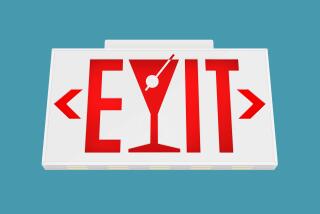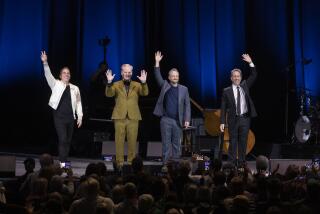It’s Party Time but This One Is a Bit Different
The Saturday night celebration at the Santa Monica Civic Auditorium looked like a typical New Year’s Eve party.
A band, which would depart from its rock and rhythm and blues repertoire to play “Auld Lang Syne” at the stroke of midnight, performed on a dimly lighted stage while, beneath colored streamers draped across the ceiling, a crowd of people on the dance floor swayed, hugged, kissed and toasted the New Year in glittery party hats.
But their glasses were not filled with champagne. These party-goers drank soft drinks and coffee--lots of coffee.
The celebrants were not drunk, or even tipsy. In fact, many boasted that they have been sober for years.
It was the third annual New Year’s Eve “Celebration of Life” organized by Alcoholics Anonymous.
An AA official said the $15-a-ticket party, which drew nearly 4,000 people, was held to raise funds and to “get our members together for a good time and keep ‘em sober over the busiest holiday for drunks of the year.”
The party did not start like most New Year’s Eve celebrations. It opened like a typical AA meeting, with several speakers climbing onto a stage to talk about their experiences as alcoholics.
“I used to sit around with a bunch of guys on the couch and get high, but not anymore,” said one 23-year-old, who identified himself only as John. “This is the first New Year’s when I feel like I really belong. I mean these people know me for who I really am.”
Another AA member, a driving school counselor who identified herself as Victoria, said that for years she did not think it was possible to enjoy such an occasion without alcohol.
“I mean alcohol is everywhere during the holidays. People constantly offer it,” she said.
“It was real scary the first time I went to this party because I thought, ‘What do you do if you’re not drinking?’ I mean it had become such a habit that I just didn’t know how to have fun without it,” the 2 1/2-year AA member said.
“But, I didn’t want to be alone on New Year’s, so I went. I found out that it wasn’t so hard after all because everyone was going through the same thing. We were so busy dancing and talking to one another that we didn’t think about the people who were at other parties drinking.”
Keeping everyone in good spirits was the job of the “Wowie!” committee. A crew of nine AA members roamed tirelessly through the crowd at the seven-hour party, which began at 7:30 p.m., handing out party favors and perking up anyone who appeared lonely or nervous.
By 9 p.m., the enormous auditorium was filled with smoke--while this was a crowd that avoided alcohol, there was no such attitude toward cigarettes; a majority of the crowd was smoking.
“I’ll ask people to dance or just talk to them and introduce them to others so that everyone has a good time,” said Mary, a data processing manager who led the “Wowie!” team. “That’s the key.”
There was no dress code, so guests arrived in everything from tuxedos and sequined gowns to jeans and sweat shirts.
“We didn’t want to discourage anyone from coming, so we didn’t set any rules--except no drinking,” Mary said.
The deregulated environment reflects the concept behind Alcoholics Anonymous, whose Los Angeles groups hold nearly 2,000 meetings a week. For 53 years, the worldwide organization of 2 million admitted alcoholics, which is financed by member contributions, has operated with few rules. There are no group leaders or trained counselors. Members need not attend meetings.
“All we ask is that they have a desire to stop drinking,” said Noel, an AA official. “And they have to believe in some higher power that will help them do that.”
Noel’s wife, Judy, said that before her husband became sober, “New Year’s used to be terrible. It would start off fun, but then he would start drinking and it would end up in arguments, usually about who would drive home. Now we’re here with all these people, and no one’s drinking and I don’t have to worry.”
More to Read
Sign up for Essential California
The most important California stories and recommendations in your inbox every morning.
You may occasionally receive promotional content from the Los Angeles Times.










